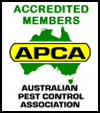Week 3 - Day 14 - Bees & Wasps
ESSENTIAL READING BEFORE COMMENCEMENT OF COURSE:
Urban
Pest Management in Australia: 2004
Edition, UNSW Press, Sydney
by
J Gerozisis and P Hadlington
- Chapter 6 - Pages 51 to 52.
Chapter 6 – Types of Insects - order hymenoptera - ants, bees and wasps - appearance - biology and habits - pest status
Pest status:
General
A great
many bees and wasps can inflict a severe sting. The
stinging apparatus is the modified ovipositor, which is used
to inject venom into the victim's flesh. Ants and wasps
are capable of extracting their stings after use and although
honey bees try to do so, they rarely succeed as the barbs
on the lancets hold the sting so firmly that the bee must
tear itself away in order to escape.
In Australia there is really only one. Species of bee, which
poses a threat to man and that, is the introduced honeybee, Apis
mellifera. Like other introduced animals, large
numbers of these can now be found living in the wild where
it nests mostly in hollow trees, caves and old buildings.
Native
Bees
There are over 2000 species of bees native to Australia
of which hundreds occur in Australia.
Sizes range from 2mm to 25mm.
Large variation in colour.
Some are hairy and others are bare.
Hairy bees carry pollen in special hairs on the hind legs.
Hairless bees swallow the pollen mixed with nectar.
Most native bees are solitary. Each female constructs
its own nest. Some nest in the ground, others in cavities.
Most females have a sting but none are aggressive.
Males play no part in nest construction but only search for
and fertilise the female.
Honeybees
Honeybees often break away from the commercial hives
and establish themselves in areas, which cause danger and
concern to man.
Treatment may be required where bees cannot be
removed in places such as cavity walls.
Few chemicals are registered for control of bees.
Care must be taken when destroying a hive. Bees may
become aggressive and attack passers by and the operator.
European
wasp and English wasp
The hymenopteran insects known as wasps can also pose quite
a severe threat to the safety of humans and animals. Many
species are capable of inflicting severe stings but two species
which have gained prominence in some parts of Australia are
the European wasp (Vespula germanica) and the
English wasp (Vespula vulgaris). Both of these
species have been introduced from overseas. The European
wasp can now be found in Tasmania, Victoria, Sydney and some
country areas of N.S.W. The English wasp can be found in
Victoria.
Description
The workers of both species are about the same size as bees
but have conspicuous lemon-yellow banded markings on a
black body. The colourless wings are folded longitudinally
when at rest.
Nests
They construct rounded community nests, normally oval in
shape, usually about 1 metre in length but, here in Australia,
where colonies may live over winter, the nests may be 3 to
4 metres high and contain up to 100,000 individuals. They
are predatory social insects and often act as scavengers
in urban areas. They tend to nest around human habitation
where there are greater opportunities for finding food. This
food may include fruits, confectionery, cakes or soft drinks. European
wasps also destroy honeybees. In spring and summer, the wasps
are very aggressive and will swarm to attack anybody whom
they consider a threat to the nest. The sting is more
painful than that of a bee and each wasp may sting the victim
many times.
Materials
required for removal
The following materials will usually be needed to remove
honey bee colonies from buildings.
Bee working supplies
Veil
Bee suit
Gloves
Knife
Wire and/or string
Pliers
Buckets with covers for honey comb and scrap comb
Paint brush
Dust pan
Water for drinking and cleanup
Tools for structural work
Ladder(s)
Hammer and nails
Crow bar
Saw (skill + cord, hand, chain + fuel)
Tin foil for sealing holes
Scaffold material for hive suspension
Staple gun
Safe
Removal of Bees
Removing honey bee nests from cavities (walls of houses,
hollow trees) is a time-consuming, labour-intensive practice
that should be undertaken by professionals. Continuous honey
bee flight activity to and from a hole in a building is an
indication of a nest. Many times, this can be confirmed by
listening for bees buzzing inside.
An experienced beekeeper usually can remove bees and combs
from easily accessible places like hollow trees, but often
bees live in building walls or are tucked away where they
are impossible to reach.
Simply killing bees in a cavity with an insecticide can have
serious consequences:
|
